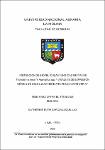Mostrar el registro sencillo del ítem
Obtención de biopelículas fúngicas mixtas de Trichoderma reesei y Aspergillus spp. Y análisis de expresión génica de celulasas mediante PCR cuantitativa
| dc.contributor.advisor | Samolski Klein, Ilanit | |
| dc.contributor.author | García Luquillas, Katherine Ruth | |
| dc.date.accessioned | 2020-09-09T04:39:23Z | |
| dc.date.available | 2020-09-09T04:39:23Z | |
| dc.date.issued | 2020 | |
| dc.identifier.uri | https://hdl.handle.net/20.500.12996/4424 | |
| dc.description | Universidad Nacional Agraria La Molina. Facultad de Ciencias. Departamento Académico de Biología | es_PE |
| dc.description.abstract | Los sistemas fermentativos mediante biopelículas fúngicas son de gran interés industrial debido a su alta eficiencia en la producción de enzimas celulolíticas y lignocelulolíticas. Por otra parte, los cultivos mixtos han mostrado altos títulos de enzimas celulasas, así como la expresión de rutas biosintéticas inactivas en monocultivos. En este estudio, se compararon biopelículas mixtas de Trichoderma reesei QM6a y Aspergillus niger ATCC 10864 con sus respectivos monocultivos a nivel de actividad enzimática celulolítica y del análisis de expresión de genes celulasas y sus reguladores. Con el propósito de obtener biopelículas óptimas para realizar el estudio, se modificaron factores determinantes como la velocidad de agitación, cepas, soporte, etapas de cultivo, porcentaje de inóculo y fuente de carbono. Tras 24 horas de cultivo en presencia de carboximetilcelulosa (CMC), las biopelículas mixtas exhibieron mayor actividad enzimática β-endoglucanasa que las respectivas biopelículas simples, mientras que la actividad β-glucosidasa en el sistema mixto fue mayor solamente con respecto al monocultivo de T. reesei. Asimismo, a nivel de productividad, la sinergia observada en el sistema mixto fue significativa solamente con respecto a la biopelícula simple de T. reesei. Para determinar qué genes eran responsables del sinergismo enzimático observado, se diseñaron cebadores específicos para cada hongo. Los resultados del análisis de expresión génica mediante qPCR indicaron que la actividad β-glucosidasa observada en las biopelículas mixtas se debe al aporte de T. reesei y no de A. niger. Se concluyó que el diálogo molecular establecido entre ambos hongos en la biopelícula mixta promueve la producción de celulasas en T. reesei, descartándose que el sinergismo sea consecuencia de una complementariedad de funciones enzimáticas, sino más bien de los mecanismos de regulación que tienen lugar en la interacción interespecífica. | es_PE |
| dc.description.abstract | Fungal biofilm fermentative systems are of high industrial importance due to its high efficiency in the production of cellulolytic and lignocellulolytic enzymes. On the other hand, mixed cultures have exhibited high cellulase enzyme titer and the expression of biosynthetic pathways that are not active in monocultures. In this study, mixed biofilms of Trichoderma reesei QM6a and Aspergillus niger ATCC 10864 were compared against their respective monocultures in respect of the cellulolytic enzyme activity and gene expression analysis of cellulase genes and its regulators. In order to obtain optimal biofilms to carry out the study, determining factors such as agitation speed, compatibility between strains, holder, cultivation phases, inoculum percentage and carbon source were modified. After 24 hours of culture with carboxymethylcellulose (CMC), these mixed biofilms exhibited higher endoglucanase enzymatic activity than the respective simple biofilms, while the βglucosidase activity in the mixed system was higher only with respect to T. reesei monoculture. Likewise, at the productivity level, the synergy observed in the mixed system was significant only with respect to simple biofilm of T. reesei. To determine which genes were responsible for the observed enzyme synergism, specific primers were designed for each fungus. The results of gene expression analysis by qPCR indicated that the βglucosidase activity observed in mixed biofilms is due to the contribution of T. reesei and not of A. niger. It was concluded that molecular dialogue established Between both fungi in the mixed biofilm promotes the production of cellulases in T. reesei, ruling out that the synergism is consequence of an enzymatic functions complementarity, but rather to the regulatory mechanisms that take place in the interspecific interaction. | en_US |
| dc.format | application/pdf | en_US |
| dc.language.iso | spa | es_PE |
| dc.publisher | Universidad Nacional Agraria La Molina | es_PE |
| dc.rights | info:eu-repo/semantics/openAccess | en_US |
| dc.rights.uri | https://creativecommons.org/licenses/by-nc-nd/4.0/ | * |
| dc.subject | Celulasa | es_PE |
| dc.subject | Enzimas | es_PE |
| dc.subject | Trichoderma | es_PE |
| dc.subject | Aspergillus | es_PE |
| dc.subject | Hongos | es_PE |
| dc.subject | Cultivos iniciadores | es_PE |
| dc.subject | Trichoderma reesei | es_PE |
| dc.subject | PCR | es_PE |
| dc.subject | Marcadores genéticos | es_PE |
| dc.subject | Métodos de ensayo | es_PE |
| dc.subject | Respuesta de la planta | es_PE |
| dc.subject | Experimentación en laboratorio | es_PE |
| dc.subject | Evaluación | es_PE |
| dc.subject | Perú | es_PE |
| dc.title | Obtención de biopelículas fúngicas mixtas de Trichoderma reesei y Aspergillus spp. Y análisis de expresión génica de celulasas mediante PCR cuantitativa | es_PE |
| dc.type | info:eu-repo/semantics/bachelorThesis | en_US |
| thesis.degree.discipline | Biología | es_PE |
| thesis.degree.grantor | Universidad Nacional Agraria La Molina. Facultad de Ciencias | es_PE |
| thesis.degree.name | Biólogo | es_PE |
| dc.subject.ocde | http://purl.org/pe-repo/ocde/ford#1.06.01 | es_PE |
| renati.author.dni | 47787311 | es_PE |
| dc.publisher.country | PE | es_PE |
| dc.type.version | info:eu-repo/semantics/publishedVersion | en_US |
| renati.advisor.orcid | https://orcid.org/0000-0002-1883-7795 | es_PE |
| renati.advisor.dni | 10542748 | es_PE |
| renati.type | https://purl.org/pe-repo/renati/type#tesis | es_PE |
| renati.level | https://purl.org/pe-repo/renati/level#tituloProfesional | es_PE |
| renati.discipline | 511206 | es_PE |
| renati.juror | Espejo Joya, Rosa Amelia | |
| renati.juror | Kitazono Sugahara, Ana Akemi | |
| renati.juror | Villena Chávez, Gretty Katherina |
Ficheros en el ítem
Este ítem aparece en la(s) siguiente(s) colección(ones)
-
CIE-BI Tesis [229]



